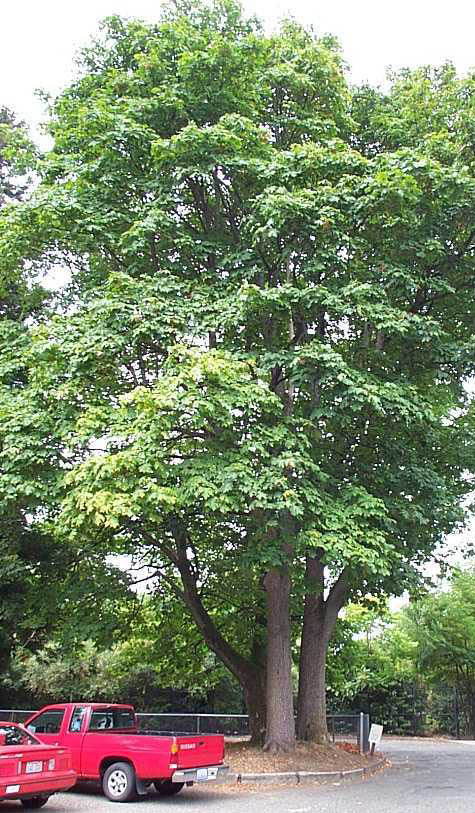| Plant of the Month: April 2002 |
| Bigleaf Maple |
| "Big" is the perfect word for Bigleaf maple. As far as maples go, nothing about this species is anything but big. Leaves the size of a dinner plate sometimes measure nearly 2' wide -- hence the name macrophyllum, from Greek macro (large) and phyllon (leaf). Even in winter, the stout branches and large buds suggest exceptional size. |
| The profuse winged seeds are the offspring of comparatively conspicuous yellow flowers, which are borne in dangling clusters up to 8 1⁄2" long. Each cluster bears as many as 176 florets, usually during April; these tender, edible delicacies are rich in nectar. Make sure no bugs are on them, then try eating some. Just pop them raw into your mouth. If that is not enough, when the plump fresh twigs elongate in May and June you can peel off their "skin" and munch them as you would celery stalks. If our climate was more severe -- with consistent frosty nights and warm days -- we could make syrup from the maple's sap, as is done with Sugar maple. |
| Bigleaf maple ranges from SW British Columbia through California, mostly confined to the coastal strip, within 200 miles of the Pacific Ocean. The hefty, often burled trunks, can be clothed green with luxuriant mosses and licorice ferns. The tallest are well over 100' and the record was 158' in 1989 (Mount Baker National Forest). Trunks can grow 8' thick, though the largest ever noted was almost 12' thick in 1993 (in Oregon). It provides a useful wood. |
| In October, the great leaves usually turn a gold of average luster, rarely bright yellow or glowing. Most maples from Back East bear prettier fall color. The autumn leaves are wafted down by wind or pelting rain, revealing brown, winged seeds, 1.5-3" long, covered with tiny bristles. You can eat the sprouted seeds, abundant in spring, often weedy in gardens. Use them as you would alfalfa or bean sprouts. They are not choice, but offer a bit of diversity and wild food to the diet. |
It may be Seattle's most common tree, in terms of sheer numbers. A specimen at Seattle's Carkeek Park is almost 9 1⁄2' thick. But since Bigleaf maple does not reproduce as readily in shade as do certain other trees, including imported European maples (Norway maple Acer platanoides; and Sycamore maple Acer Pseudoplatanus), it is declining in Seattle. Old specimens are dying; young maples in shady woods are often the naturalized European species.
Back |

photo by Brigid Jo Hurley |
|
|

